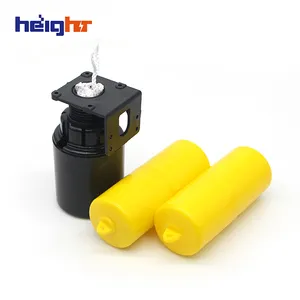A float switch is a vital instrument for monitoring liquid levels within a tank. It operates by floating atop the liquid and adjusts its position in response to any changes in the liquid's surface level. This elegantly simple mechanism is indispensable for the automated management of pumps, monitoring tank levels, and triggering alarms under certain liquid level conditions. The adaptability of a float switch renders it a critical tool in a wide array of industrial and household settings.
Types and Characteristics of Float Switches
Diverse models of float switches exist, each tailored with distinct features to meet the demands of various applications. The single-stage float switch, for example, is widely employed in residential environments for straightforward on/off tasks. Multistage float switches provide intricate control and are apt for industrial operations that necessitate several level detection points. Cable float switches offer installation versatility and are well-suited for deep tanks or wells. Magnetic float switches, operating on magnetic coupling principles, are celebrated for their dependability and are frequently chosen for precision-critical applications.
Structure and Operation of Float Switches
The architecture of a float switch typically includes a float, a stem, and a microswitch. The float, buoyant with the liquid level, is tethered to a stem that actuates a microswitch within the housing. This microswitch either completes or interrupts an electrical circuit, thereby initiating actions such as activating a pump or sounding an alarm. Some float switches feature multiple floats on a single stem for layered control, while others may incorporate a counterweight to ensure stability in agitated liquids.
Materials and Properties
Materials for float switches are chosen based on their compatibility with the liquid and the operational environment. Stainless steel is valued for its robustness and corrosion resistance, ideal for demanding industrial settings. Plastics and PP are selected for their buoyancy and resistance to chemicals, especially in corrosive liquid applications or when cost efficiency is paramount. Nylon is another prevalent choice due to its durability and chemical resistance spectrum.
Business Usages and Applications
Float switches play a pivotal role in a multitude of sectors. In water treatment facilities, they regulate pumps and signal tank fill levels. Manufacturing plants rely on them to manage the flow of coolants and lubricants. The food and beverage industry employs them to maintain accurate filling levels in containers. By automating these tasks, float switches enhance operational efficiency, diminish downtime, and avert overflows or pump dry runs, thereby adding value to businesses.
Functions and Tasks
A float switch is engineered to fulfill the pivotal role of detecting fluid levels. It can switch pumps on or off, open or close valves, and trigger alarms. Certain float switches come equipped with hysteresis control to prevent rapid cycling in volatile fluids, thus safeguarding pumps and prolonging their lifespan.
Features and Unique Selling Points
Key attributes of float switches include their high efficiency and waterproof design. Some variants allow for adjustable switch points, while others boast a compact form for confined spaces. Their unique selling propositions may encompass straightforward installation, minimal maintenance needs, and the capacity to function under extreme temperatures or pressures.
Benefits and Positive Outcomes
The deployment of a float switch yields a plethora of advantages, such as averting tank overflows, sustaining optimal fluid levels, and conserving water or other resources. They bolster system longevity by ensuring equipment operates within safe limits. The automation they facilitate results in labor savings and heightened safety for workers.
How to Use and Operate Effectively
For effective operation, a float switch should be mounted to allow the float unimpeded movement with the liquid level. It is crucial to verify the switch's compatibility with the liquid's specific gravity and to ensure no obstructions hinder the float's motion.
How to Choose the Right Model
Choosing the appropriate float switch requires consideration of the liquid's characteristics, the tank's dimensions and shape, and the environmental conditions. It is equally important to align the switch's electrical specifications with the system's operational demands.
How to Clean and Maintain
Cleaning a float switch generally involves clearing any detritus or deposits that might disrupt its function. Routine maintenance checks should include verifying the switch's performance and inspecting the electrical connections for signs of deterioration or corrosion.
How to Install
Installation of a float switch must adhere to the manufacturer's instructions. This typically entails securing the switch at the required level within the tank and integrating it with the control system. Ensuring proper sealing is essential to avert leaks, particularly in pressurized environments.
Target Audience and Meeting Needs
Float switches cater to sectors such as water treatment, manufacturing, and agriculture. Each industry has distinct requirements that float switches can satisfy, from dependable level management in water treatment plants to precision filling in beverage production.
How does a float switch improve system automation?
A float switch markedly advances system automation by delivering instantaneous liquid level data, which can be utilized to automate the engagement and disengagement of pumps, the operation of valves, or the activation of alarms. This automation ensures more efficient system operation, reducing manual oversight and the likelihood of human error.
What are the maintenance requirements for a float switch?
Maintenance for a float switch is typically straightforward. Nonetheless, periodic inspections are advisable to confirm the device is unobstructed and functioning accurately. For float switches in more severe environments, more regular checks may be warranted to sustain peak performance.
Can a float switch be used in any type of liquid?
Although float switches are highly adaptable, they are not universally suited to all types of liquids. The float switch material must be resistant to the liquid to prevent any adverse reactions. For aggressive or corrosive substances, options like stainless steel or certain plastics are recommended. It is imperative to review the float switch's specifications or consult with experts from suppliers like Alibaba.com to guarantee compatibility with the intended medium.





























 浙公网安备 33010002000092号
浙公网安备 33010002000092号 浙B2-20120091-4
浙B2-20120091-4